Orchids
The family Orchidaceae is one of the largest plant families in the world, but is mostly tropical in its occurrence and we have rather fewer species in the temperate zone. Still, the family is very diverse with a number of species found in East Anglia in most types of habitats. Epiphytic species (growing on substrates other than the ground, such as on tree branches) are plentiful in the tropics, but our species are all terrestrial and, from an orchid point of view, mostly rather small. Most species produce upright spikes containing a quantity of flowers that open from the bottom of the spike upwards in sequence. As this is such a diverse group, this page will help narrow your search, once you have arrived here from the flower colour pages.
The main purpose of this page is to attempt to break this family up into manageable groups, so that the pages you are led to do not get too big by containing a large number of species. At worst, if you follow a link from here and do not see your plant, return to this page and try another link. Idnetification is largely made using the flowers as the leaves on most species tend to wither before flowering time. However, where leaf features may be important in aiding identification, they are mentioned.
Be sure to read the texts below carefully, as they contain identification information that may not be visible in the photographs; clicking to the next stage will help you get to the exact species.
Use the photos below to narrow your search to a group, then click on the picture to go to the next stage.
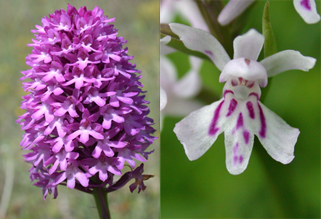 |
Pink, Marsh & Spotted Orchids
This is a relatively large, complex group of orchid species that perhaps typify terrestrial orchids in our region. The flower spikes mostly consist of dense, often compact spikes of flowers that are either pink or whitish with darker pink markings. Some species occur in quite large colonies in grassy places and can be very variable in colour, often including white individuals scattered amongst the population. |
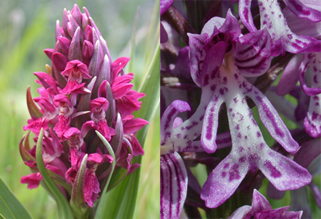 |
Pink, Marsh & Spotted Orchids
This is a relatively large, complex group of orchid species that perhaps typify terrestrial orchids in our region. The flower spikes mostly consist of dense, often compact spikes of flowers that are either pink or whitish with darker pink markings. Some species occur in quite large colonies in grassy places and can be very variable in colour, often including white individuals scattered amongst the population. |
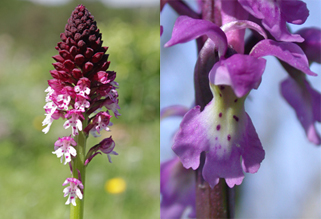 |
Pink, Marsh & Spotted Orchids
This is a relatively large, complex group of orchid species that perhaps typify terrestrial orchids in our region. The flower spikes mostly consist of dense, often compact spikes of flowers that are either pink or whitish with darker pink markings. Some species occur in quite large colonies in grassy places and can be very variable in colour, often including white individuals scattered amongst the population. |
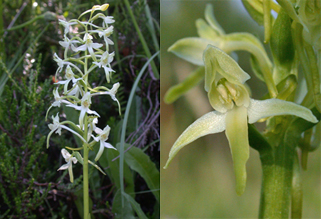 |
Butterfly Orchids
A group of just two species of orchids in our region. Rather easily told from other orchids by the flowers which are creamy white or slightly green-tinted, very long-spurred and which are carried in open, loose spikes. |
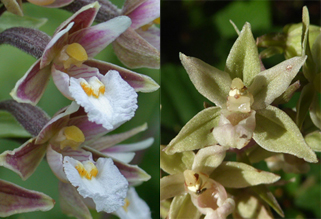 |
Helleborines
A very variable group of orchids, typically found in shady (often coppiced) woodland or in good quality wetland sites depending on species. Most have open flowers with broad sepals and petals and showy labellums. The leaves are typically rather broad and persistent during the flowering period. |
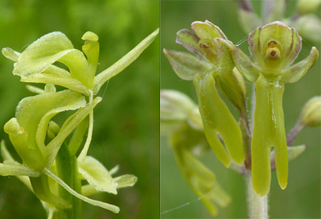 |
Green/Yellow Orchids
Despite their perceived beauty, some orchids are - frankly - underwhelming! This page covers orchids that have typically rather small flowers, in large or small spikes and predoninantly greenish or greenish-yellow in colour. However, note the typical orchid flower structure with three sepals and two petals forming the upper part of the flower (either appearing openly star-shaped or drawn together to form a tube or hood) and the lower part of the flower formed from a single, larger petal (the labellum), which may be curved or hang vertically. |
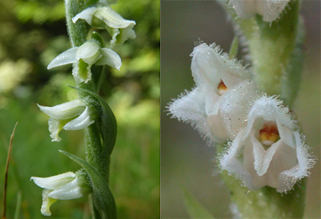 |
Lady's-tresses
Just two species of these orchids occur in our region and are easily told from other orchids by their very small, white or off-white flowers that are arranged spirally up the stem, like the treads on a spiral staircase. The flowers are covered in glandular hairs and the spikes are often only 10-15cm in height. |
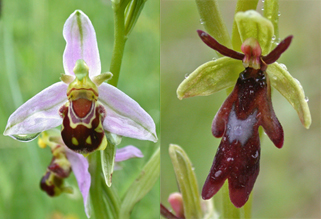 |
Bee Orchids
A remarkable group of orchids that use deception in their visual appearance and sent to attract specific insect species as pollinators. The flowers have five green or pink, relatively narrow petals and sepals in the top half of the flower. The lower petal which forms the labellum is enlarged into a variety of forms, sone of which somewhat resemble insect bodies. Most have brown or maroon tones with patches of other colours present. |
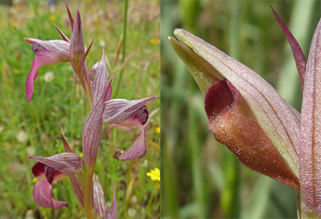 |
Tongue Orchids
Peculiar little plants that could be easily overlooked in longer grass. Short spikes of greenish-brown or rusty-tinted flowers. The petals all cluster together into a tube, from which protrudes the long, narrow, lower petal or labellum. Currently extremely rare in East Anglia. |
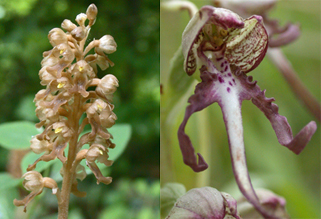 |
Miscellaneous Orchids
If you feel sure that you have an orchid but not found it yet, here's a couple of oddball species with rather dull flowers and which don't fit into the other categories above. These species have a typical orchid appearance with flowers showing a distinct lower lip or labellum, a hooded upper part to the flowers and these arranged in a many-flowered, upright spike. |